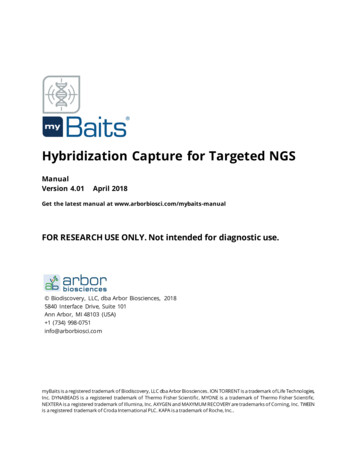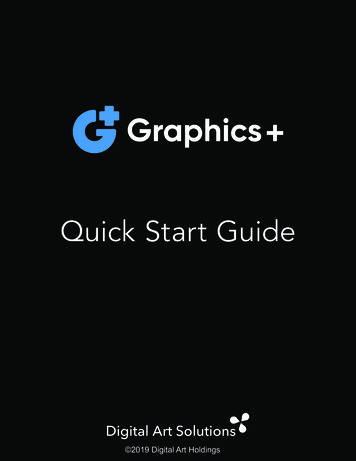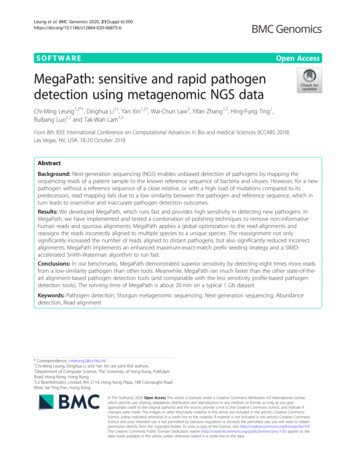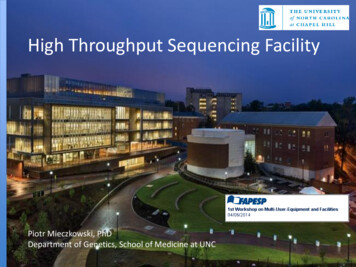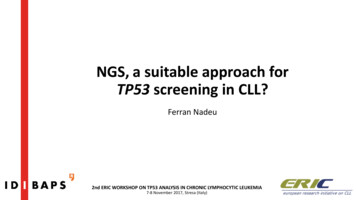
Transcription
NGS, a suitable approach forTP53 screening in CLL?Ferran Nadeu2nd ERIC WORKSHOP ON TP53 ANALYSIS IN CHRONIC LYMPHOCYTIC LEUKEMIA7-8 November 2017, Stresa (Italy)
The Sanger sequencing bottleneck1 patient20 patients400 patients TP534 PCR/case*TP534 PCR/case*TP534 PCR/case* 4 PCRs100 PCRs1600 PCRs* Exon 4, exons 5-6, exon 7, exons 8-9.
The Sanger sequencing bottleneck1 patient20 patients400 patients TP53, SF3B1, BIRC3,TP53NOTCH1and ATM4PCR/case* 75 PCR/caseTP53, SF3B1, BIRC3,TP53NOTCH1and ATM4PCR/case* 75 PCR/caseTP53, SF3B1, BIRC3,TP53NOTCH1 and ATM4 PCR/case* 75 PCR/case 75PCRs4 PCRs100 PCRs1500PCRs300001600 PCRsPCRsNadeu et al Blood 2016
Outline1. NGS overcomes this Sanger sequencing bottleneck (focus on the Access-Array system)2. NGS for TP53 analysis:a) Access-Array systemb) Comparison of NGS libraries3. Pros and cons of the use of NGS:a) Sensitivityb) Bioinformatic analysisc) Accuracyd) Possibility to study several genes simultaneously (i.e. panel of genes)
Access-Array system (Fluidigm) – Quick overviewAmplicon-based15 amplicons of 180bp4-Primer Amplicon Tagging
Access-Array system (Fluidigm) – Quick overviewIFC controller AX2304 individual reactionschambers (30 nL)48.48 Access Array IFC (Integrated Fluidic Circuit)
Access-Array system (Fluidigm) – Quick overviewIFCBioMarkcontrollerHDAX48.48 Access Array IFC (Integrated Fluidic Circuit)
Access-Array system (Fluidigm) – Quick overviewIFC controller AX48.48 Access Array IFC (Integrated Fluidic Circuit)
Access-Array system (Fluidigm) – Quick overviewClean-up48.48 Access Array IFC (Integrated Fluidic Circuit)
Access-Array system – Up to 480 ampliconsMultiplexing2nd PCR done in a96-well plate in aor al ther ocyclerFigures adapted from Access-Array System User Guide (Fluidigm).
Outline1. NGS overcomes this Sanger sequencing bottleneck (Access-Array system)2. NGS for TP53 analysis:a) Access-Array systemb) Comparison of NGS libraries3. Pros and cons of the use of NGS:a) Sensitivityb) Bioinformatic analysisc) Accuracyd) Possibility to study several genes simultaneously
Coverage/depth in GAT42ATGCCTG2466666ATG0Spencer et al J Mol Diagn 2014
Access-Array system for TP53 analysis
Access-Array system (Fluidigm) – CoverageNadeu et al Blood 2016
Access-Array system (Fluidigm) – CoverageA coverage 1000x was obtained in 85% of the sequence in 95% of the samplesNadeu et al Blood 2016
Comparison of NGS libraries for TP53 screeningCapture hybridization-basedAmplicon-based Acces-Array - Flluidigm AmpliSeq - ThermoFisher (Ion Torrent) SureSelect - Agilent Genereadv2/QIASeq - QIAgen SeqCap EZ System -Nimblegen/Roche Multiplicom - Agilent xGen Lockdown - IDT TruSeq Custom Amplicon - Agilent Haloplex – Agilent TruSeq Custom Amplicon DS – Agilent Nextera XT - Illumina NexteraXT - Illumina
Comparison of NGS libraries for TP53 screeningAmplicon-basedCapture hybridization-based
Outline1. NGS overcomes this Sanger sequencing bottleneck (Access-Array system)2. NGS for TP53 analysis:a) Access-Array systemb) Comparison of NGS libraries3. Pros and cons of the use of NGS:a) Sensitivityb) Bioinformatic analysisc) Accuracyd) Possibility to study several genes simultaneously
Pros and cons of NGS: SensitivityNadeu et al Blood 2016
Pros and cons of NGS: SensitivityRossi et al Blood 2014: 30% (15/50) patients carried only subclonal TP53 mutations8% (4/50) patients carried isolated del(17p)NGS: 92% (46/50) of patients with TP53 alterationsSanger FISH: 70% (35/50) of patients with TP53 alterationsNadeu et al Blood 2016: 34% (16/47) patients carried only subclonal TP53 mutations9% (4/47) patients carried isolated del(17p)NGS: 91% (43/47) of patients with TP53 alterationsSanger SNP array: 66% (31/47) of patients with TP53 alterations
Pros and cons of NGS: Bioinformatic analysisSpencer et al J Mol Diagn 2014Sequencing error rate:PlatformChemistryRead lengthGenomic context.
Pros and cons of NGS: Bioinformatic analysisSVCNadeu et al Blood 2016
Pros and cons of NGS: Bioinformatic analysisSVCNadeu et al Blood 2016
Pros and cons of NGS: Accuracy%(Sanger sequencing on302 regions/genes detected 69 mutations)100% specificity and100% sensitivityVAF 12%VAF (43 cases carrying high frequency mutationswere subjected to a second round of NGS)100% reproducibility88 mutations verified by AS-PCR77 mutations verified by a 2nd round of NGS13/13 were also verified by AS-PCRVerification: AS-PCR or 2nd run of NGSAfter a non-stringent custom filtering 75% specificity % of VAFNadeu et al Blood 2016
Pros and cons of NGS: ScalabilitynTime Euros BenefitGenes targetedPrecision medicineCostHands-on01Number of genes targetedn
Pros and cons of NGS: Panel of genesNadeu et al Leukemia 2017
Pros and cons of NGS: Panel of genesNadeu et al Leukemia 2017Guièze et al Blood 2015
Take home messagesNGS libraries and TP53 Easy design Short hands-on time Compatible with multiple sequencing platforms (Illumina, Ion Torrent, etc.) Percentage of amplification success 95%, and good accuracy ( 90% mapping to target) Uniform coverage Highly sensitive and reproducible approach to detect mutations in TP53 and other genes in clinical samplesNGS in the clinics Many different library approaches work well. We may face a CLL (or lymphoma) panel rather than analyzing an individual gene Which genes? How we validate it in larger cohorts? Should we sequence the normal DNA? It could be useful for the study of ATM mutations and for the variant calling.Bioinformatic approach (still not well defined) A gold-standard bioinformatic pipeline for deep-targeted NGS is not yet stablished. Limited accuracy in the detection of clinically relevant very low VAF mutations. Verification may be needed. Feasible identification of CNA [del(17p), del(11q)] from the same NGS data is still pending. should all this be uniform for the different centers?
AcknowledgmentElías CampoCristina CapdevilaSara GuijarroJulio DelgadoGuillem ClotAnna EnjuanesMagda PinyolHelena Suárez-CisnerosMontse SanchezLaura PlaThank you for your attention!
TruSeq Custom Amplicon - Agilent TruSeq Custom Amplicon DS -Agilent NexteraXT - Illumina SureSelect - Agilent SeqCap EZ System -Nimblegen/Roche xGen Lockdown - IDT Haloplex -Agilent Nextera XT - Illumina Comparison of NGS libraries for TP53screening. Comparison of NGS libraries for TP53screening Amplicon-based Capture hybridization-based. Outline 1. NGS overcomes .

